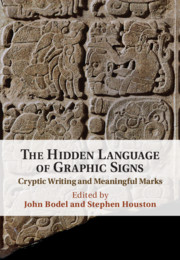Book contents
- The Hidden Language of Graphic Signs
- The Hidden Language of Graphic Signs
- Copyright page
- Contents
- Contributors
- Abbreviations
- Introduction
- Part I Hidden Writing
- One Buried and Camouflaged Writing in Early China
- Two Dazzled and Absorbed
- Three Impossible Unities
- Four Inscribe and De-scribe/Cipher and De-cipher
- Five Script, Pseudoscript, and Pseudo-pseudoscript in the Work of Filippo Lippi
- Six Numerals as Letters
- Part II Legible Signs
- References
- Index
Three - Impossible Unities
Full-Figure Glyphs among the Maya
from Part I - Hidden Writing
Published online by Cambridge University Press: 23 August 2021
- The Hidden Language of Graphic Signs
- The Hidden Language of Graphic Signs
- Copyright page
- Contents
- Contributors
- Abbreviations
- Introduction
- Part I Hidden Writing
- One Buried and Camouflaged Writing in Early China
- Two Dazzled and Absorbed
- Three Impossible Unities
- Four Inscribe and De-scribe/Cipher and De-cipher
- Five Script, Pseudoscript, and Pseudo-pseudoscript in the Work of Filippo Lippi
- Six Numerals as Letters
- Part II Legible Signs
- References
- Index
Summary
This chapter presents practices of Egyptian hieroglyphic writing that differ from regular hieroglyphic writing by their difficulty and their visual otherness. In a variety of settings, hieroglyphic writing that is altered visually or made deliberately difficult to read is exposed, designed to entice through its otherness and virtuosity, and often boldly affirmative. In other settings, altered writing is additionally withdrawn from view: even without a beholder or reader, altered writing here establishes, through its very otherness, an indexical contiguity with another world. Combined, these practices illustrate how Egyptian hieroglyphic writing was conceived of, and played with, by some of its most proficient ancient users on two defining levels: visually and in its orientation to reading. As implicit metadiscourses, they tell of native Egyptian conceptions of the functions and nature of hieroglyphic writing: not along ideologies of a transparency of writing to meaning or direct access to information, but instead of a writing carrying denser significations and with inherent performative potential. In the inscriptions presented here, writing obfuscates but does notconceal. It entices, it dazzles, it absorbs. Through such delays, significations beyond the words are made experienceable, in and through writing itself, and writing itself is made transformative.
- Type
- Chapter
- Information
- The Hidden Language of Graphic SignsCryptic Writing and Meaningful Marks, pp. 54 - 79Publisher: Cambridge University PressPrint publication year: 2021
- 2
- Cited by

